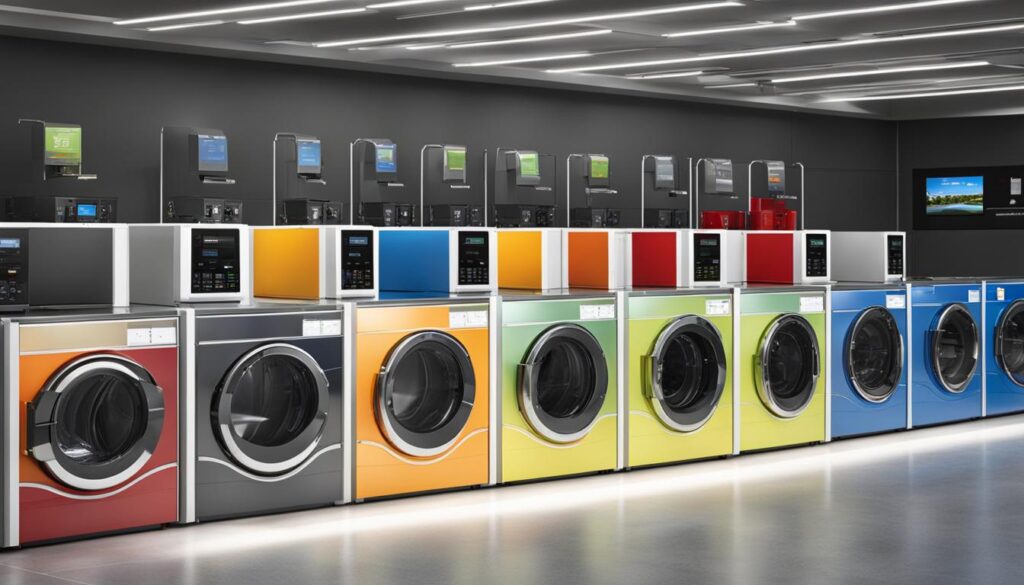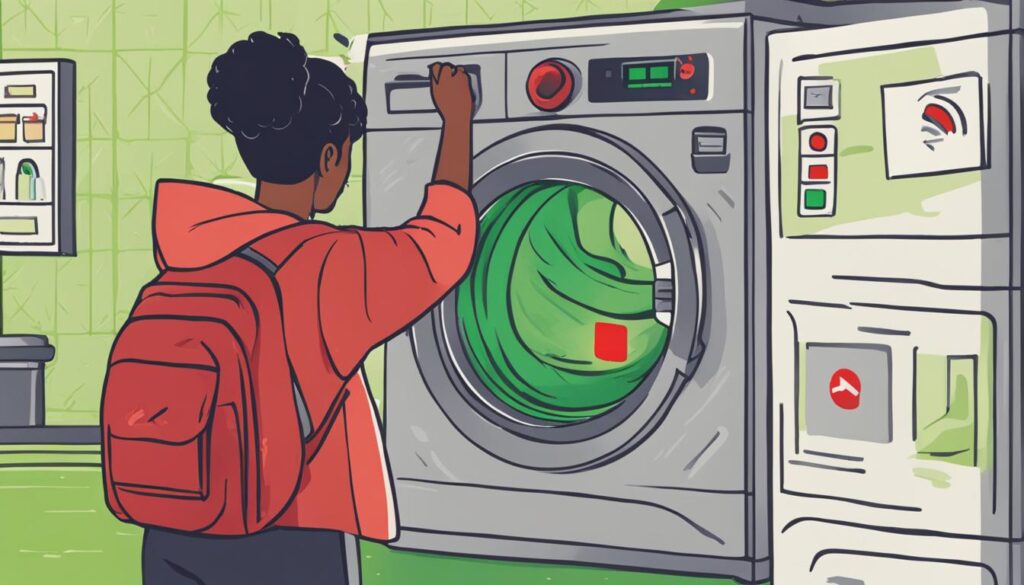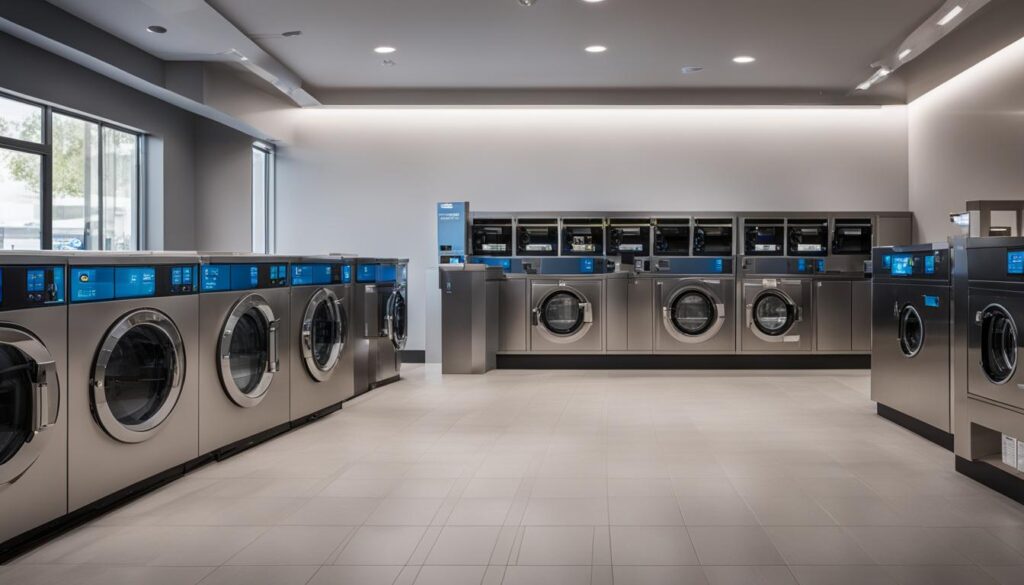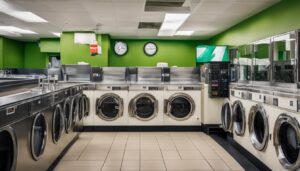In today’s economy, managing costs is of utmost importance for laundromats and dry cleaners. One area where significant savings can be achieved is energy consumption. The average laundromat consumes around 75,000 kWh of electricity per year, while dry cleaners use approximately 69,000 kWh per year. By implementing energy-saving techniques, these businesses can reduce their environmental impact and improve their bottom line without compromising on quality.
In this article, we will explore a range of laundromat energy-saving options, from upgrading to energy-efficient laundry machines to implementing eco-friendly practices. By adopting these sustainable solutions and embracing cost-effective laundry equipment, you can transform your laundromat into a green and efficient business.
Key Takeaways:
- Implementing energy-saving techniques can significantly reduce costs and environmental impact for laundromats and dry cleaners.
- Optimizing equipment efficiency and upgrading to energy-efficient machines can save energy without compromising performance.
- Intelligent lighting solutions, such as LED lights and motion sensors, can further reduce energy consumption.
- Regular maintenance of heating and cooling systems, along with smart thermostats and insulation, can optimize HVAC efficiency.
- Education and awareness programs for staff and customers can foster a culture of energy conservation in the laundry industry.
The Power of Energy Efficiency in the Laundry Industry
Laundromats and dry cleaners are key examples of energy-intensive businesses that consume substantial amounts of electricity and water. The importance of energy efficiency in these industries cannot be overstated. By implementing energy-efficient practices, laundromats and dry cleaners can significantly reduce their environmental impact and operational costs.
According to energy consumption statistics, the average laundromat consumes around 75,000 kWh of electricity per year, while dry cleaners consume approximately 69,000 kWh per year. These numbers highlight the need for implementing strategies to improve energy efficiency in this sector.
One of the key strategies for improving energy efficiency is by upgrading to high-efficiency equipment. Investing in energy-efficient washers, dryers, and extractors can result in significant energy savings without compromising on performance. These machines are designed to consume less energy while maintaining the same level of productivity, making them a cost-effective solution for laundromats and dry cleaners.
Optimizing energy usage is another essential aspect of improving energy efficiency in the laundry industry. By actively monitoring and managing energy consumption, businesses can identify areas of waste and implement changes to reduce their overall energy usage.
Benefits of Energy Efficiency in the Laundry Industry:
- Reduced environmental impact: Implementing energy-efficient practices helps to reduce greenhouse gas emissions and preserve natural resources, making the laundry industry more sustainable.
- Lower operational costs: By reducing energy consumption, laundromats and dry cleaners can lower their utility bills, resulting in significant cost savings over time.
- Enhanced reputation: Embracing energy efficiency demonstrates a commitment to sustainability, which can enhance a business’s reputation and attract environmentally conscious customers.
- Regulatory compliance: Energy-efficient practices align with government regulations and environmental standards, ensuring businesses stay compliant with relevant legislation.
By harnessing the power of energy efficiency, laundromats and dry cleaners can create a positive impact on both their bottom line and the environment. Upgrading to high-efficiency equipment and optimizing energy usage are essential steps towards building a more sustainable and cost-effective laundry business.
Optimizing Equipment Efficiency
In order to reduce energy consumption in laundromats and dry cleaners, it is essential to maximize the efficiency of laundry machines and equipment. By investing in high-efficiency machines, right-sizing equipment, and utilizing programmable controls, businesses can significantly save on energy costs without compromising performance.
One effective strategy is to choose Energy Star-rated washers, dryers, and extractors. These machines are specifically designed to consume less energy while maintaining optimal performance. With Energy Star-rated equipment, you can achieve energy savings of up to 45% compared to standard models.
Another important consideration is right-sizing your machines. Choosing the appropriate machine size for the volume of laundry being processed can have a significant impact on energy usage. Oversized machines not only consume more energy but also waste water and detergent. Conversely, undersized machines can lead to longer operating times and decreased productivity. By right-sizing your machines, you can optimize energy usage and improve overall efficiency.
Programmable controls are another valuable tool in optimizing equipment efficiency. These controls allow you to set specific wash and dry cycles, enabling you to tailor operations to the needs of each load. By programming machines to run at off-peak hours or during times when energy rates are lower, you can further reduce energy costs. Additionally, programmable controls help prevent unnecessary water and energy usage by ensuring that machines operate at the most efficient levels for each load.
Benefits of Optimizing Equipment Efficiency:
- Significant energy savings with Energy Star-rated machines
- Better utilization of water and detergent resources
- Improved productivity and reduced operating times
- Lower overall utility costs
By focusing on optimizing equipment efficiency through the use of high-efficiency machines, right-sizing equipment, and programmable controls, laundromats and dry cleaners can achieve substantial energy savings. These energy-saving initiatives not only contribute to cost reduction but also demonstrate a commitment to sustainability and environmental responsibility.
Implementing Intelligent Lighting
When it comes to energy-saving techniques, lighting might not be the first thing that comes to mind. However, it plays a significant role in reducing energy consumption in laundromats and dry cleaners. By implementing intelligent lighting solutions, you can make a substantial impact on your energy bills while embracing sustainability.
LED Lighting: One of the most effective ways to save energy and reduce costs is by switching to LED lights. LED lighting is highly energy-efficient, lasting up to 25 times longer than traditional incandescent bulbs. This means fewer replacements and lower maintenance costs for your business. Additionally, LED lights produce high-quality illumination, enhancing the overall lighting experience for customers.
Motion Sensors: Installing motion sensors in your laundromat or dry cleaner can further optimize energy usage. Motion sensors detect movements within a given area and automatically turn lights on or off accordingly. This eliminates the need for manual switching and ensures that lights are only activated when needed, minimizing unnecessary energy consumption.
Natural Lighting: Harnessing natural lighting during daylight hours is another eco-friendly and cost-effective approach. By strategically placing windows or skylights in your laundry facility, you can take advantage of natural sunlight to provide illumination, reducing reliance on artificial lighting. Not only does this contribute to energy savings, but it also creates a pleasant and inviting atmosphere for customers.
“Switching to LED lights, installing motion sensors, and utilizing natural lighting can significantly reduce energy consumption in laundromats and dry cleaners.”
Implementing intelligent lighting solutions in your laundry business not only helps conserve energy but also creates a more sustainable and enjoyable environment for your customers. By reducing your carbon footprint and cutting down on energy costs, you can make a positive impact on both the planet and your bottom line.
The Benefits of Implementing Intelligent Lighting:
| Benefits | Description |
|---|---|
| Energy Savings | LED lights consume significantly less energy than traditional incandescent or fluorescent bulbs, resulting in cost savings on electricity bills. |
| Longer Lifespan | LED lights have a longer lifespan compared to traditional lighting options, reducing the frequency of replacements and maintenance costs. |
| Improved Efficiency | Motion sensors ensure lights are only activated when necessary, minimizing energy waste and optimizing efficiency. |
| Natural and Inviting Atmosphere | By utilizing natural lighting, you can create a welcoming environment for your customers while reducing reliance on artificial lighting. |
Optimizing Heating and Cooling
Heating and cooling systems play a significant role in energy consumption for laundromats and dry cleaners. To maximize efficiency and reduce energy costs, we recommend the following strategies:
Regular Maintenance
Regular maintenance is essential for ensuring optimal performance and energy efficiency of HVAC systems. By scheduling routine inspections and tune-ups, you can identify and address any issues promptly. This proactive approach helps prevent major malfunctions and extends the lifespan of your equipment, saving you both energy and money in the long run.
Upgrading to Smart Thermostats
Smart thermostats offer advanced features that enable precise temperature control and energy management. These innovative devices allow you to program temperature settings based on occupancy patterns, time of day, and even weather conditions. With the ability to remotely monitor and adjust settings via Wi-Fi connectivity, you can ensure that your heating and cooling systems operate only when necessary, further reducing energy waste.
Adequate Insulation
Proper insulation is crucial for maintaining a consistent indoor temperature and preventing heat loss or gain. By properly insulating your laundromat or dry cleaner, you can reduce the workload on your HVAC system and minimize energy consumption. Pay special attention to areas such as windows, doors, and any potential air leaks, as these are common sources of heat transfer.
By implementing regular maintenance practices, upgrading to smart thermostats, and investing in adequate insulation, you can optimize the heating and cooling efficiency of your laundromat or dry cleaner. These energy-saving measures not only help reduce operating costs but also contribute to a more sustainable business.
“Regular maintenance, smart thermostats, and insulation are key factors in optimizing heating and cooling efficiency in laundromats and dry cleaners.” -Laundry Pros
Energy-Saving Recommendations for Heating and Cooling
| Recommended Strategies | Description |
|---|---|
| Regular Maintenance | Ensure scheduled inspections and tune-ups to detect and fix any HVAC issues promptly. |
| Upgrading to Smart Thermostats | Install programmable and Wi-Fi-enabled thermostats for precise control and energy management. |
| Adequate Insulation | Properly insulate your laundromat or dry cleaner to minimize heat loss or gain. |
Implementing these energy-saving recommendations can have a significant impact on reducing your laundromat or dry cleaner’s environmental footprint while also improving your bottom line.
Empower with Education
At [Laundromat/Dry Cleaner Name], we believe that education is a powerful tool in creating a sustainable and energy-efficient business. By providing training programs and fostering customer awareness, we can empower our staff and customers to actively participate in energy conservation efforts. Through our comprehensive approach, we aim to cultivate a culture of environmental responsibility and make a positive impact on the world around us.
Training Programs for Staff
We understand that our employees play a crucial role in the energy-saving initiatives of our business. That’s why we offer regular training sessions to educate our staff about energy-saving practices. Our training programs cover topics such as optimizing equipment efficiency, proper use of lighting, water-saving techniques, and more. By equipping our employees with the knowledge and tools they need, we empower them to be actively involved in reducing our energy consumption.
Raising Customer Awareness
Creating customer awareness is essential to promote energy-conscious behavior in our laundromat/dry cleaning facilities. We provide informative materials, such as pamphlets and posters, that highlight the importance of energy efficiency and offer practical tips for our customers to save energy during their visits. By educating our customers about the impact of their actions and the benefits of energy conservation, we encourage them to make sustainable choices.
Rewards and Incentives
We believe in rewarding and incentivizing energy-conscious behavior. At [Laundromat/Dry Cleaner Name], we offer rewards and incentives to both our staff and customers who actively contribute to our energy-saving efforts. This could include recognition programs, bonuses, discounted services, or loyalty rewards. By providing tangible benefits, we motivate everyone involved to make energy efficiency a priority.
By empowering our staff with knowledge, raising customer awareness, and offering rewards and incentives, we create a collective effort towards building a more sustainable future. Together, we can make a difference and set an example for other businesses in our industry.
The Benefits of Upgrading to Energy Star-Qualified Equipment
Upgrading to energy-efficient washers and dryers can bring about a multitude of benefits for laundromats and dry cleaners. Not only do these machines promote sustainability and environmental responsibility, but they also result in substantial savings for businesses and improved customer experiences.
Energy Star-qualified equipment stands out as a top choice for establishments aiming to reduce their carbon footprint while enjoying financial advantages. These machines are specifically designed to consume less water and energy, leading to lower utility bills and long-term cost savings.
One of the key benefits of upgrading to energy-efficient washers and dryers is the significant reduction in water consumption. With advanced technology and innovative features, these machines optimize water usage without compromising on cleaning performance. This equates to considerable water savings, ensuring a more sustainable and eco-friendly laundry operation.
Table: Comparison of Water Consumption
|
|
|
| — | — |
| Energy Star-Qualified Washer | 10-15 gallons |
| Standard Washer | 25-30 gallons |
By choosing energy-efficient equipment, laundromats and dry cleaners can also benefit from reduced energy consumption. Energy Star-qualified washers and dryers are designed to use less electricity while delivering the same high-quality results. This translates into lower energy bills and a more financially viable business model.
In addition to water and energy savings, upgrading to energy-efficient washers and dryers often comes with improved cycle times. These machines leverage advanced technologies, such as high-speed spin cycles and optimized cleaning algorithms, to provide faster and more efficient operations. Consequently, customers experience shorter waiting times, leading to enhanced satisfaction and loyalty.
To emphasize the advantages of upgrading to energy-efficient washers and dryers, consider the following quote:
“By investing in energy Star-qualified washers and dryers, we were able to reduce our water consumption by 50% and our energy usage by 40%. Not only did we achieve significant cost savings, but our customers also appreciate the faster cycle times, making it a win-win situation for everyone.” – Michelle Thompson, Co-owner of EcoClean Laundromat
Testimonials from Satisfied Customers
- “The energy-efficient washers and dryers at XYZ Laundry have not only saved me money on each visit but also drastically reduced my waiting time. I’m impressed with their commitment to sustainability!” – Sarah J., XYZ Laundry customer
- “Ever since they upgraded to energy-efficient machines, the laundry process at ABC Cleaners has become much quicker and more efficient. I appreciate their dedication to both the environment and customer satisfaction.” – John D., ABC Cleaners customer
Investing in energy-efficient washers and dryers is a smart choice for laundromats and dry cleaners looking to optimize their operations, reduce costs, and satisfy customer demands. The combination of water and energy savings, along with improved cycle times, positions these machines as essential assets for businesses striving for long-term sustainability and success.
Harnessing the Power of Solar Energy
Switching to clean energy sources like solar power is a wise investment for laundromats and dry cleaners. By installing solar panels on your premises, you can reduce your dependency on conventional energy sources and make a positive impact on the environment.
Solar panels generate electricity by harnessing sunlight, a clean and renewable energy source. By utilizing this clean energy, we can significantly reduce greenhouse gas emissions and combat climate change.
One of the primary benefits of solar energy is its potential to lower electricity bills. Once installed, solar panels convert sunlight into electricity, reducing the need to draw power from the grid. This can result in substantial long-term savings for laundromats and dry cleaners.
Moreover, installing solar panels can make your business eligible for federal and state incentives. The government offers several programs that provide tax credits, grants, and rebates to businesses that invest in renewable energy sources. Taking advantage of these incentives can further offset the cost of solar panel installation and provide additional financial benefits for your business.
Not only does solar energy offer financial advantages, but it also enhances your brand’s reputation for sustainability. In today’s environmentally-conscious society, customers appreciate businesses that prioritize clean energy and sustainable practices. By going solar, you demonstrate your commitment to reducing carbon emissions and promoting a greener future.
The Benefits of Solar Energy for Laundromats and Dry Cleaners:
- Reduces dependency on conventional energy sources
- Lowers electricity bills and long-term energy costs
- Qualifies for federal and state incentives, such as tax credits and grants
- Enhances brand reputation for sustainability
Embracing solar energy is an excellent way for laundromats and dry cleaners to contribute to a cleaner and more sustainable future. With the potential for significant cost savings, environmental benefits, and the opportunity to position your business as a leader in energy-efficient practices, installing solar panels is a decision that can create a positive impact on both your bottom line and the planet.
| Benefits of Solar Energy | Details |
|---|---|
| Reduces electricity bills | Solar panels generate clean electricity, reducing reliance on the grid and lowering utility costs. |
| Qualifies for incentives | Government programs offer tax credits, grants, and rebates to businesses that invest in solar energy. |
| Enhances brand reputation | Being a leader in clean energy demonstrates a commitment to sustainability and attracts environmentally-conscious customers. |
The Advantages of Efficient Lighting
When it comes to energy savings in laundromats and dry cleaners, upgrading to energy-efficient LED lighting is a smart choice. LED lights offer several advantages that can make a significant impact on energy consumption and cost savings.
First and foremost, LED lights consume less energy compared to traditional lighting options. They are highly efficient, converting a larger percentage of electricity into light rather than heat, resulting in reduced energy consumption. This not only helps to lower utility bills but also contributes to a more sustainable operation.
Furthermore, LED lights have an extended lifespan, which means fewer replacements and maintenance efforts. On average, LED lights can last up to 50,000 hours or more, ensuring long-term durability and reliability. This extended lifespan not only saves on replacement costs but also reduces waste, making LED lights an eco-friendly choice.
Additionally, LED lights provide improved brightness, enhancing the overall lighting experience for customers. With better visibility, customers can conveniently navigate the laundromat or dry cleaner, making their laundry experience more pleasant and efficient.
Incorporating LED lighting into your laundry business not only achieves energy savings and extended lifespan but also contributes to a greener environment. By reducing energy consumption, you can lower your carbon footprint and positively impact the planet.
Water-Saving Techniques for Laundromats and Dry Cleaners
When it comes to running a sustainable laundromat or dry cleaner, conserving water is a crucial factor. By implementing water-saving techniques, you can not only reduce your water consumption but also minimize your environmental impact. Here are some effective strategies to consider:
1. Implement Water-Efficient Machines
Investing in water-efficient washing machines and dryers is an excellent way to minimize water usage without compromising on performance. Look for models with high water efficiency ratings, such as those certified by the WaterSense label. These machines are designed to use less water while still providing excellent cleaning results.
2. Monitor and Fix Leaks Promptly
Regularly inspecting your equipment and plumbing for leaks is essential to prevent water wastage. Even small leaks can lead to significant water loss over time. Implement a proactive leak monitoring system and promptly address any leaks to ensure optimal water usage efficiency.
3. Reuse Condensed Water
Collecting and reusing condensed water from your machines can help conserve water in your laundromat or dry cleaner. This water, often referred to as “gray water,” can be repurposed for non-potable uses like cleaning floors or flushing toilets. Implementing a system to capture and store condensed water can significantly reduce your overall water consumption.
Water-saving techniques such as implementing water-efficient machines, promptly fixing leaks, and reusing condensed water are crucial in reducing water consumption in the laundry industry.
By adopting these water-saving techniques, you can make a positive environmental impact while also potentially lowering your water bills. Take an active role in conserving water and contribute to the sustainability of your laundromat or dry cleaning business.
Importance of Clean Equipment for Energy Efficiency
Regularly cleaning lint screens, inspecting and servicing machines, and ensuring adequate insulation are crucial steps in maximizing equipment efficiency and minimizing energy wastage in laundromats and dry cleaners.
Lint screens can quickly become clogged with lint and debris, obstructing airflow and reducing the efficiency of dryers. By cleaning lint screens after each use, we can maintain proper airflow, ensuring clothes dry in a timely manner while minimizing energy consumption.
Additionally, inspecting and servicing machines on a regular basis helps identify and address any mechanical issues that may affect energy efficiency. From checking belts and hoses to calibrating temperature settings, routine maintenance ensures optimal performance and prevents energy loss.
Another key aspect to consider is heat loss. Insulating machines, ductwork, and hot water pipes helps retain heat within the system, reducing the need for additional energy consumption to compensate for heat loss. By addressing insulation gaps and investing in effective insulation materials, we can significantly improve energy efficiency and minimize wasted energy.
In summary, maintaining clean equipment through regular cleaning, inspections, and servicing, as well as ensuring proper insulation, is essential for maximizing energy efficiency in laundromats and dry cleaners. By taking these steps, we can reduce energy waste, lower operating costs, and contribute to a more sustainable and environmentally-friendly business.
Countdown Timer Lights for Energy Efficiency
When it comes to reducing electricity use in laundromats and dry cleaners, every small change counts. One effective way to minimize unnecessary energy consumption is by installing countdown timer lights in your laundry rooms.
Countdown timer lights are designed to activate only when needed, allowing you to save energy by avoiding the unnecessary use of lights. These energy-efficient lighting solutions automatically turn off after a certain period of inactivity, helping to reduce electricity usage and lower utility bills.
By implementing countdown timer lights in your laundry facility, you can ensure that lights are only active when customers are present and actively using the space. This not only helps to conserve electricity but also promotes a greener and more sustainable environment for your business.
The Benefits of Countdown Timer Lights:
- Reduced Energy Consumption: By activating lights only when necessary, countdown timer lights effectively reduce energy waste and lower electricity costs.
- Improved Efficiency: With automated activation and deactivation, these lights eliminate the need for manual switching, saving time and effort for staff.
- Enhanced Customer Experience: Countdown timer lights ensure that customers have well-lit spaces while using your laundry facility, enhancing their overall experience.
- Longer Lifespan: The controlled usage of lights with countdown timer systems can extend the lifespan of bulbs, reducing maintenance and replacement costs.
Implementing countdown timer lights is a practical and cost-effective way to reduce electricity use in your laundromat or dry cleaner. By making this energy-efficient lighting upgrade, you can contribute to a more sustainable future while improving operational efficiency and customer satisfaction.
An Example of Countdown Timer Light Installation
To better understand how countdown timer lights can be implemented in a laundromat or dry cleaner, let’s look at an example:
| Laundry Room Area | Countdown Timer Lights Installed | Energy Savings |
|---|---|---|
| Washing Area | Yes | 15% |
| Drying Area | Yes | 20% |
| Folding Area | No | N/A |
In the example above, the installation of countdown timer lights in the washing and drying areas resulted in significant energy savings of 15% and 20%, respectively. However, the absence of countdown timer lights in the folding area had no direct impact on energy consumption.
By strategically installing countdown timer lights in areas where they will have the greatest impact, you can maximize energy savings and optimize your efforts in reducing electricity use.
Encouraging the Use of Cold Water
At our laundromat, we are passionate about promoting energy efficiency and eco-friendly laundry practices. One simple yet impactful way to achieve this is by encouraging our customers to wash their clothes in cold water.
Energy and Cost Savings
Washing clothes in cold water can lead to significant energy and cost savings. Heating water accounts for a major portion of energy consumption in laundry machines, so skipping the hot water cycle can make a substantial difference in reducing energy usage and utility bills.
Eco-Friendly Laundry
Cold water washes are not only energy-efficient but also environmentally friendly. Using cold water helps conserve natural resources by reducing the amount of energy required to heat the water. This small change in washing temperature can have a big impact on promoting sustainability in the laundry industry.
Research has shown that washing clothes in cold water can clean them just as effectively as using warm or hot water, thanks to advancements in detergent formulations. So, you can trust that your clothes will still come out fresh and clean while minimizing your environmental footprint.
Busting the Myth: Hot Water vs. Cold Water
“Contrary to popular belief, washing clothes in cold water can be just as effective as using warm or hot water. Technological advancements in laundry detergents have made it possible to achieve excellent cleaning results in cold water cycles. So, don’t be afraid to embrace the cold and enjoy the energy and cost savings while protecting our planet.”
– Dr. Ella Thompson, Laundry Expert
Embracing cold water washes not only benefits the environment but also contributes to extending the lifespan of your clothes. Hot water can be harsh on certain fabrics and cause color fading or shrinkage over time. By opting for cold water washes, you can help preserve your clothing and reduce the need for frequent replacements.
| Benefits of Washing Clothes in Cold Water |
|---|
| Energy and cost savings |
| Eco-friendly laundry practices |
| Preserves clothing quality and lifespan |
By making a small change in your laundry routine and washing your clothes in cold water, you can contribute to a greener future and enjoy the energy and cost savings that come along with it.
Going Beyond Equipment: Additional Energy-Saving Practices
In addition to optimizing equipment, there are several other energy-saving practices that laundromats and dry cleaners can implement to further reduce their environmental impact and lower energy costs.
Upgrade to Energy-Efficient Bulbs
Replacing traditional incandescent bulbs with energy-efficient LED bulbs is a simple and effective way to save energy. LED bulbs consume significantly less electricity and have a longer lifespan, making them a cost-effective choice for lighting in laundry facilities.
Utilize Timers for Lights and Electronics
Installing timers for lights and electronics allows for better control over energy usage. By automatically turning off lights and equipment when not in use, timers can prevent unnecessary energy consumption during non-operational hours.
Explore Renewable Energy Sources
Embracing renewable energy sources is an excellent way to reduce reliance on traditional power grids and decrease the carbon footprint of laundromats and dry cleaners. Installing solar panels on the roof can generate clean, sustainable energy and potentially reduce electricity bills.
Incorporating these additional energy-saving practices into your laundry business can lead to significant energy and cost savings over time. By combining optimized equipment with efficient lighting, smart timers, and renewable energy sources, you can create a more sustainable and environmentally friendly laundromat or dry cleaner.
“The future of energy efficiency lies in not only upgrading equipment, but also adopting innovative practices that further minimize energy consumption and promote sustainability.”
| Energy-Saving Practice | Benefits |
|---|---|
| Upgrade to Energy-Efficient Bulbs |
|
| Utilize Timers for Lights and Electronics |
|
| Explore Renewable Energy Sources |
|
Conclusion
By implementing energy-saving techniques such as optimizing equipment efficiency, utilizing intelligent lighting solutions, and promoting energy conservation, laundromats and dry cleaners can significantly reduce energy consumption, save on costs, and contribute to a greener future. These energy-efficient practices not only benefit the environment but also lead to a more sustainable and profitable business.
Optimizing equipment efficiency is a crucial step in achieving energy savings. Investing in high-efficiency washers, dryers, and extractors, along with right-sizing machines and utilizing programmable controls, can significantly reduce energy consumption while maintaining excellent performance.
Intelligent lighting solutions, such as LED lights, motion sensors, and maximizing natural lighting, provide effective ways to reduce electricity usage in laundromats and dry cleaners. These solutions not only save energy but also create a more comfortable and inviting environment for customers.
Conserving water is equally important for sustainability. Implementing water-efficient machines, promptly fixing leaks, and reusing water can help reduce the water consumption of laundromats and dry cleaners, minimizing their impact on local water resources.
Education and awareness play a crucial role in empowering both staff and customers to embrace energy-saving practices. Regular training sessions, informative materials, and rewards for energy-conscious behavior foster a culture of sustainability and conservation.
Upgrading to Energy Star-qualified equipment brings a host of benefits, including reductions in water and energy usage and improved cycle times. These machines not only save costs but also enhance operational efficiency and customer satisfaction.
Exploring renewable energy sources, such as solar power, further contributes to a greener future. Solar panels can lower electricity bills, qualify for incentives, and demonstrate a commitment to clean energy.
By embracing laundromat energy-saving options and implementing energy-efficient solutions throughout their operations, laundromats and dry cleaners can achieve significant cost savings while protecting the environment. These sustainable practices not only benefit the business but also inspire positive change within the industry.
Conclusion
By implementing various energy-saving techniques, such as optimizing the efficiency of equipment, utilizing intelligent lighting solutions, and promoting energy conservation, laundromats and dry cleaners can make a significant impact on reducing energy consumption and contributing to a greener future. Not only do these practices help protect the environment, but they also lead to substantial cost savings, making them a win-win solution for businesses.
Investing in energy-efficient laundry machines, such as Energy Star-rated washers and dryers, allows for significant energy and water savings without compromising on performance. Additionally, implementing intelligent lighting systems, such as LED lights and motion sensors, helps reduce electricity usage in the laundromat, further contributing to sustainability efforts.
Moreover, by empowering staff through education and training programs, laundromat owners can foster a culture of energy conservation and instill environmentally-friendly practices. Raising customer awareness about the importance of energy efficiency and offering rewards and incentives for energy-conscious behavior can also encourage sustainable usage among patrons.
In conclusion, embracing energy-saving options in laundromats and dry cleaners not only promotes cost savings but also creates a positive impact on the environment. With the ever-increasing need for sustainability, implementing these energy-efficient practices positions your business as a leader in the industry while contributing to a greener planet for future generations.
FAQ
What are some energy-saving tips for laundromats and dry cleaners?
Implementing energy-saving techniques such as upgrading to high-efficiency equipment, optimizing energy usage, and utilizing intelligent lighting solutions can significantly reduce energy consumption in laundromats and dry cleaners.
How can upgrading to energy-efficient washers and dryers benefit my business?
Upgrading to energy-efficient washers and dryers, such as those with Energy Star ratings, can result in substantial savings. These machines consume less water and energy, leading to lower utility bills, while also providing improved cycle times and enhanced customer satisfaction.
What are the advantages of installing solar panels on my laundromat or dry cleaner?
Installing solar panels can reduce dependency on conventional energy sources, lower electricity bills, qualify for incentives such as tax credits and grants, and enhance your business’s reputation for sustainability.
How can energy-efficient lighting contribute to energy savings in laundromats and dry cleaners?
By upgrading to energy-efficient LED lighting, laundromats and dry cleaners can consume less energy, benefit from an extended lifespan of the lights, and provide improved brightness for customers.
What water-saving techniques can be implemented in the laundry industry?
Implementing water-efficient washing machines and dryers, promptly fixing leaks, and collecting and reusing condensed water can all help reduce water consumption in laundromats and dry cleaners.
How important is regular equipment maintenance for energy efficiency in laundromats and dry cleaners?
Regularly cleaning lint screens, inspecting and servicing machines, and ensuring adequate insulation can maximize equipment efficiency and minimize energy wastage in laundromats and dry cleaners.
What is the benefit of using countdown timer lights in laundry rooms?
Installing countdown timer lights can help reduce electricity use by only activating lights when needed, minimizing unnecessary energy consumption in laundromats and dry cleaners.
Can washing clothes in cold water really save energy and costs?
Yes, washing clothes in cold water can result in significant energy and cost savings. Cold water washes can clean clothes effectively while using less energy and being environmentally friendly.
Are there any additional energy-saving practices beyond equipment optimization?
Yes, in addition to optimizing equipment, other energy-saving practices include upgrading to energy-efficient light bulbs, using timers to control lights and electronics, and exploring renewable energy sources like solar power.







